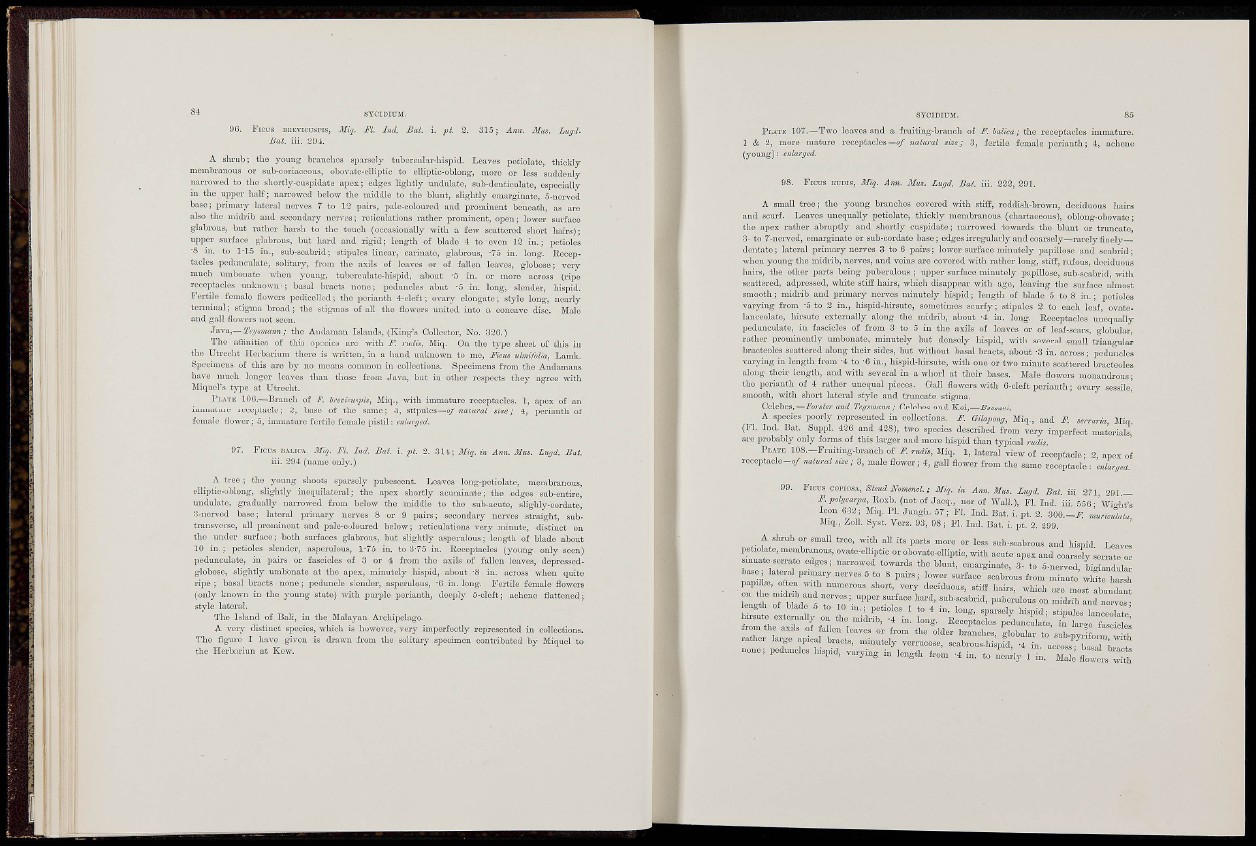
STCIDIUM:.
06. Ficus BRiivicuspis, 3Iiq. FL Lid. Bat. i. pt. 2. 315 j Am. Mas. Lugd.
Bat. iii. 291.
A shrub; tlie yoimg- brandies sparsely tubercular-hispid. Leaves petiolate, thickly
membranous or sub-coriaccous, obovate-clliptic to elliptic-oblong, more or less suddenly
narrowed to the shortly-cuspidate apes; edges lightly undulate, sub-denticuiate, especially
in the upper half; muTOwed below the middle to the blunt, slightly cmargiuato, o-ncrve"d
base; primary lateral nerves 7 to 12 pairs, pale-colom-ed and prominent beneath, as are
also the midi-ib and secondary nerves; reticulations rather prominent, open; lower surface
glabrous, but rather harsh to the touch (occasionally with a few scattered short hairs);
upper sm-face glabrous, but hard and rigid; length of blade 4 to even 12 in.; petioles
•S m. to 1-15 in., sub-scabrid; stipules linear, carinate, glabrous, -75 in. long. Receptacles
pedunculate, solitary, from the axils of leaves or of fallen leaves, globose; very
much umbouate when young, tuborculate-hispid, about -5 in. or more across (ripe
receptacles milmowQ'; basal bracts none; peduncles abut -5 in. long, slender, hispid.
Fertile female flowers pedicelled; the perianth 4-cleft; ovary elongate; style long, nearly
terminal; stigraa broad; the stigmas of all the flowers \mitcd into a concave disc. Male
and gall flowers not seen.
^?c^i\—Tc!j&mann; the Andaman Islands, (King's Collector, No. 326.)
The aflinities of this species are with F. rudis, Miq. On the t j^e sheet of this in
the Utrecht Herbaiiiim there is wi-itten, in a hand unknown to me, Ficus ulmifolia^ Lamk.
Specimens of this are by no means common in collections. Specimens from the Andamans
have much longer leaves than those from Java, but in other respects they agree with
MiquePs t j^e at Utrecht.
PLATJi) 106.'—Branch of F. hrevimnjns, Miq., with immature receptacles. 1, apex of an
immature receptacle; 2, base of the same; 3, stipules—of natural nize; 4, perianth of
female flower; 5, immature fertile female pistil; enlarged.
OR. FICUS B.4J.IC.A.. Miq. Fi. Ind. Bat. i. pt. 2. 311; 3íiq. i
iii. 294 (name only.)
Ann. Mm. Lugd. Bat.
A tree ; the young shoots sparsely pubescent. Leaves long-petiolate, membranous,
elliptic-wblong, slightly inequilateral; the apex shortly acuminate; the edges sub-entire,
undulate, gradually nai-rowed fi-om below the middle to the sub-acute, slighly-cordate,
•'3-nerved base; lateral primary nerves 8 or 9 pairs; secondary nerves straight, subtransverse,
all prominent and pale-culom-ed below; reticulations very minute, distinct on
the under surface; both sm-faces glabrous, but slightly asijerulous; length of blade about
10 in. ; petioles slender, asperiflous, l-7o in. to 3'75 in. Reccptacles (young only seen)
pedunculate, in paii's or fascicles of 3 or 4 from the axils of fallen leaves, depressedglobose,
slightly umb'onate at the apex, minutely liispid, about -8 in. across when quite
ripe ; basal bracts none; peduncle slender, asperulous, -6 in. long. Fertile female flowers
(only kno-Nm in the young state) "with purple perianth, deejily 5-clcft; achene flattened;
style lateral.
The Island of Bali, in the Malayan Archipelago,
A very distinct species, which is however, very imperfectly represented in collections.
'I'he figure I have given is drawn from the solitary specimen contributed by Miquel to
the lierbarimi at Kew.
pLATJi 107.—Two
1 & more mature
(young); enlarged.
and a fruiting-branch of F. halica; the receptacles immatm-e.
i-eceptacles —of natural size; 3, fertile female perianth; 4, achene
08. Ficus EUDis, Miq. Ann. Mus. Lugd. Bat. iii. 222, 201.
A small tree; the young branches covered with stifí, reddish-brown, deciduous hairs
and scurf. Leaves unequally petiolate, thickly membranous (chai'taceous), oblong-obovate;
the apex rather abruptly and shortly cuspidate; narrowed towards the blunt or truncate,
3- to 7-nerved, emarginate or sub-cordate base; edges irregularly and coarsely—rarely finely—
dentate; lateral piimary nerves 3 to 6 pairs; lower sm-face minutely papillose and scabrid;
when young the midrib, nerves, and veins are covered with rather long, stiff, rufous, deciduous
hairs, the other parts being puberulous ; upper surface minutely papillose, sub-scabrid, with
scattered, adpressed, white stiff hairs, whicli disappear with age, leaving the surface almost
smooth; midi-ib and primary nerves minutely hispid; length of blade 5 to 8 in.; petioles
varying from -5 to 2 in., hispid-hirsute, sometimes scm-fy; stipules 2 to each leaf, ovatelanceolate,
hirsute externally along the midrib, about -4 in. long. Receptacles unequally
pedunculate, in fascicles of from 3 to 5 in the axils of leaves or of leaf-scars, globular,
rather prominently umbonate, minutely but densely hispid, with several small triangular
bracteoles scattered along their sides, but without basal bracts, about -3 in. across; peduncles
varying in length from -4 to '6 in., hispid-hii-sute, with one or two minute scattei-ed bracteoles
along theii' length, and with several in a whorl at their bases. Male flowers monandrous;
the perianth of 4 rather unequal pieces. Gall flowers with 6-cleft perianth; ovary sessile^
smooth, with short lateral style and truncate stigma.
Calehns,—Forster and Tegsmann ; Celebes and Kei,—Semtr/.
A species poorly represented in coUections. F. Gilajmng, Miq., and F. serraría, Miq
(FL Ind. Bat. Suppl. 426 and 428), two species described from very imporfect materials'
are probably only forms of this lai-ger and more hi,spid than ty^Dical rudis. '
PLATE lOS—Frmting-branch of F rudis, Miq. 1, lateral view of receptacle- 2 apex of
receptacle-./ 3, male flower; 4, gall flower from the same receptacic : 'enlargeU.
99. FICUS Steud Nomencl; Miq. in Ann. Mm. Lugd. Bat iii 271, 291 - ^
F. polgcarpa, Roxb. (not of Jacq., nor of Wall.), Fl. Ind. iii 556 • 'wioht's
Icon 632; Miq. PL Jnngh. 57; FL Ind. Bat. i. pt. 2. 300.-J^. Lridua
Miq,, Zoll. Syst. Verz. 93, 98; Fl. Ind. Bat. i. pt. 2. 299.
A shrub or small tree, with aU its parts more or less sub-scabrous and hispid Leaves
petiolate, membranous, ovate-elhptie or obovate-elliptic, with acute apex and coarsely ¡eiTate oJ
anuate-serra e edges; n.-rowed towai-ds the blunt, emarginate, to o-neiwed, bi^nd^:
base; lateral primary nerves 5 to 8 pairs; lower sm-face scabrous from minute
papi 1., often with numerous short, very deciduous, stiff hairs, which are most b.ndan